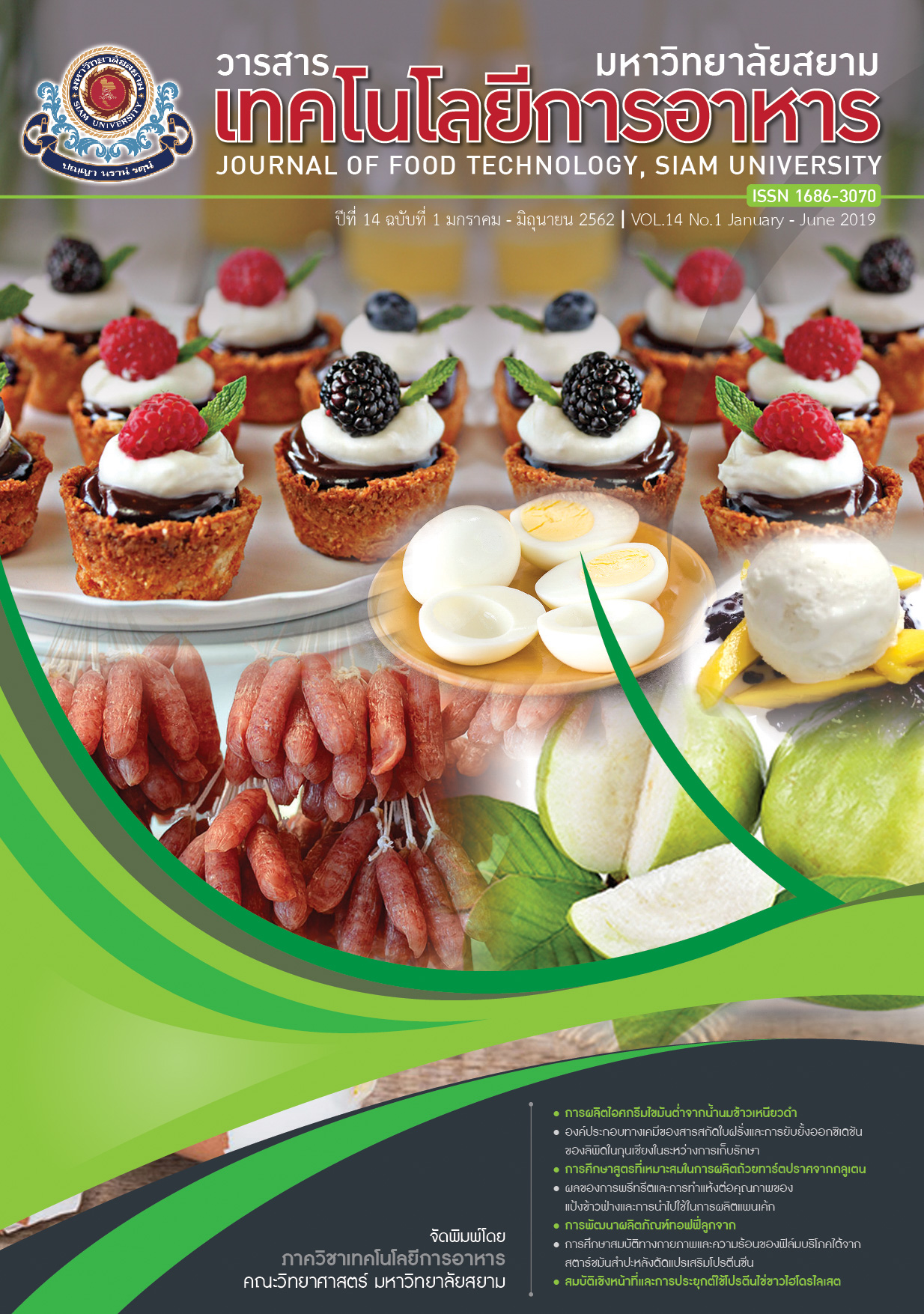Study on Physical and Thermal Properties of Edible Films from Modified Cassava Starch Incorporated with Zein Protein
Main Article Content
Abstract
Edible films are direct food contact materials i.e. thin films for food wrapping and film coating. Cassava starch is abundant in Thailand, cheap, it is often used as a raw material in food industry and film formability. However, edible films from cassava starch have some drawbacks such as poor mechanical properties and water sensitivity. Therefore, the properties of edible films from cassava starch have to be improved with different methods such as chemical modification of starch, and blending with hydrophobic polymers, etc. The present research studied preparation and properties of edible films from modified cassava starch with added zein protein by film casting using glycerol as a plasticizer. An unmodified cassava starch film with added zein protein was used as a control film. The results showed that modified cassava starch films with added zein protein were transparent, pale yellow and possess thickness in the range of 0.19–0.21 mm. The oxidized cassava starch film with added zein protein was homogenous, soft and flexible, whereas control film was stiff and strong. The cross-linked cassava starch film with added zein protein exhibited poor homogeneity of starch phase and protein phase, so its tensile properties and water absorption were inferior. Modification of cassava starch with oxidation gave good compatibility between cassava starch and zein protein.
Article Details
Copyrights of all articles in the Journal of Food Technology available in print or online are owned by Siam University and protected by law.
References
[2] Krochta, J.M. (2002). Protein-based films and coatings. CRC Press. Boca Raton, FL.
[3] Mehyar, G.F. Al-Ismail, K. Han, J.H. and Chee, G.W. (2012). Characterization of edible coatings consisting of pea starch, whey protein isolate, and carnauba wax and their effects on oil rancidity and sensory properties of walnuts and pine nuts. Journal of Food Science. 77(2): E52-E59.
[4] Dang, K.M. and Yoksan, R. (2016). Morphological characteristics and barrier properties of thermoplastic starch/chitosan blown film. Carbohydrate Polymers. 150: 40-47.
[5] Kechichian, V. Ditchfield, C. Veiga-Santos, P and Tadini, C. C. (2010). Natural antimicrobial ingredients incorporated in biodegradable films based on cassava starch. LWT-Food Science and Technology. 43(7): 1088-1094.
[6] Vu, H.P.N. and Lumdubwong, N. (2016). Starch behaviors and mechanical properties of starch blend films with different plasticizers. Carbohydrate Polymers. 154: 112-120.
[7] Muzanila, Y.C. Brennan, J.G. and King, R.D. (2000). Residual cyanogens, chemical composition and aflatoxins in cassava flour from Tanzanian villages. Food Chemistry. 70: 45-49.
[8] Lumdabwong, N. (2014). Analysis and modification of starch. Bangkok: Asia Digital Press.
[9] Yokesahachart, C. and Yoksan, R. (2011). Effect of amphiphilic molecules on characteristics and tensile properties of thermoplastic starch and its blends with poly (lactic acid). Carbohydrate Polymers. 83(1): 22-31.
[10] Shukla, R. and Cheryan, M. (2001). Zein: the industrial protein from corn. Industrial crops and products. 13:171-192.
[11] Goa, P. Wang, F. Gu, F. Ning, J. Liang, J. and Li, N. and Ludescher, R.D. (2017). Preparation and characterization of zein thermo-modified starch films. Carbohydrate Polymers. 157: 1254-1260.
[12] Chanvrier, H. Colonna, P. Valle, G.D. and Lourdin, D. (2005). Structure and mechanical behavior of corn flour and starch-zein based materials in glassy state. Carbohydrate Polymers. 59: 109-119.
[13] Corradini, E. Medeiros, E.S. Carvalho, A.J.F. Curvelo, A.A.S. and Mattoso, L.H.C. (2006). Mechanical and morphological characterization of starch/zein blends plasticized with glycerol. Journal of Applied Polymer Science. 101(6): 4133–4139.
[14] Corradini, E. Carvalho, A.J.F. Curvelo, A.A.S. Agnelli, J.A.M. and Mattoso, L.H.C. (2007). Preparation and characterization of thermoplastic starch/zein blends. Materials Research. 10(3): 227-231.
[15] Lim, S. and Jane, J. (1994). Storage stability of injection-molded starch-zein plastics under dry and humid conditions. Journal of Environmental Polymer Degradation. 2(2): 111-120.
[16] Ryu, S.Y. Rhim, J.W. Roh, H.J. and Kim, S.S. (2002). Preparation and physical properties of zein-coated high-amylose corn starch film. LWT - Food Science and Technology. 35(8): 680-686.
[17] Santiago, G.T. Gente, C.R. Lara, S.G. Verdolotti, L. Maio, E.D. and Lannace, S. (2014). Strategies to produce thermoplastic starch–zein blends: effect on compatibilization. Journal of Polymers and the Environment. 22(4): 508-524.
[18] Zeng, M. Huang, Y. Lu, L. Fan, L. and Lourdin, D. (2011). Effects of filler-matrix morphology on mechanical properties of corn starch–zein thermo-moulded films. Carbohydrate Polymers. 84(1): 323-328.
[19] Habeych, E. Dekkers, B. Goot, A.J. and Boom, R. (2008). Starch–zein blends formed by shear flow. Chemical Engineering Science. 63: 5229-5238.
[20] Xie, S.X. Liu, Q. and Cui, S.W. (2005). Food carbohydrates chemistry, physical properties, and applications. CRC press. Boca Raton, FL.
[21] Garcia, E.A. Feria, J.S. Villalobos, R.R. Gonzalez, F.R. Perez, A.J. and Huicochea, E.F. (2014). Properties of edible films based on oxidized starch and zein. International Journal of Polymer Science. Article ID 292404: 9 pages.
[22] Spence, K.E. Jane, J. and Pometto, A.L. (1995). Dialdehyde starch and zein plastic: Mechanical properties and biodegradability. Journal of environmental polymer degradation. 3(2): 69-74.
[23] Zhang, Y.R. Wang, X.L. Zhao, G.M. and Wang, Y.Z. (2012). Preparation and properties of oxidized starch with high degree of oxidation. Carbohydrate Polymers. 87: 2554-2562.
[24] Shi, R. and Li, B. (2016). Synthesis and characterization of cross-linked starch/ lignin films. Starch/Starke. 68: 1-9.


